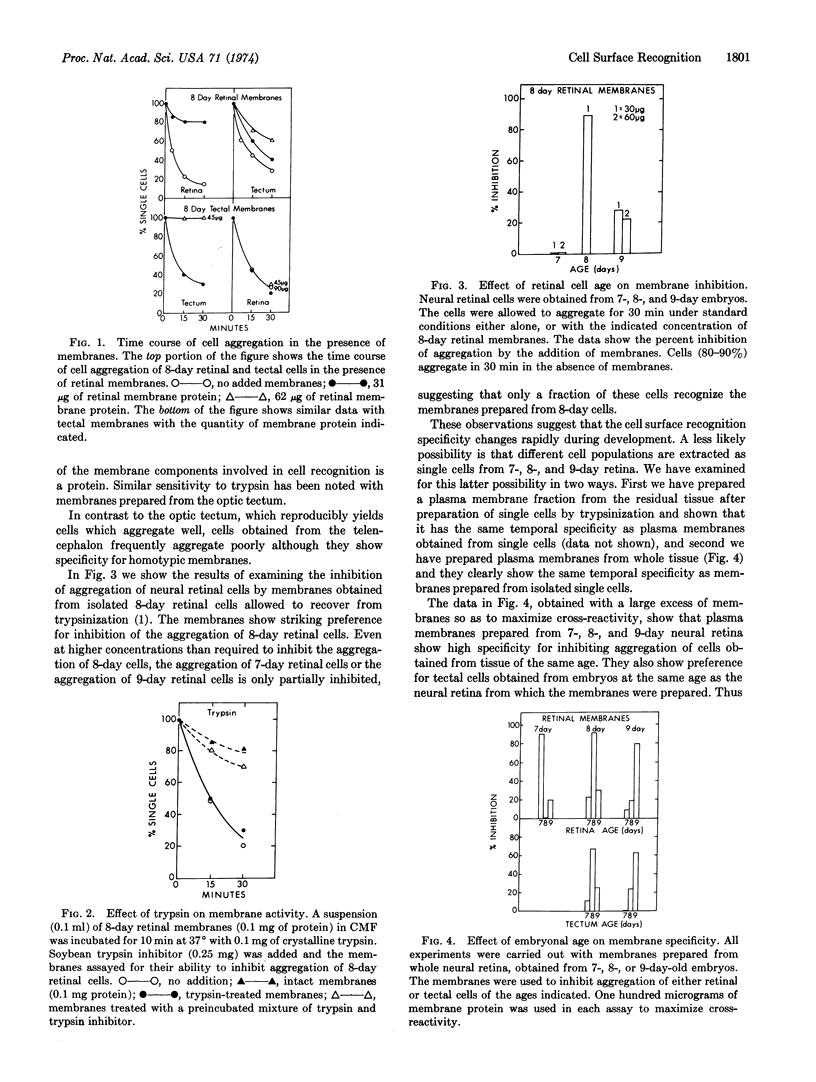Abstract
Plasma membranes have been prepared from optic tectum and neural retina of chick embryos. These membranes specifically inhibit the aggregation of homotypic cells. Plasma membranes prepared from each of these regions obtained from chick embryos at 7,8, and 9 days of development show specificity for homotypic cells of the same age and cross-react weakly with homotypic cells of different ages. Thus cell-surface recognition changes with age of development, and most of the cells in each region have a common cell-surface recognition specificity. Tectal cells react weakly with retinal cell membranes, but no inhibition of retinal cell aggregation by tectal cells has been noted.
Keywords: plasma membrane, neural retina, optic tectum
Full text
PDF


Selected References
These references are in PubMed. This may not be the complete list of references from this article.
- Barbera A. J., Marchase R. B., Roth S. Adhesive recognition and retinotectal specificity. Proc Natl Acad Sci U S A. 1973 Sep;70(9):2482–2486. doi: 10.1073/pnas.70.9.2482. [DOI] [PMC free article] [PubMed] [Google Scholar]
- COULOMBRE A. J. Correlations of structural and biochemical changes in the developing retina of the chick. Am J Anat. 1955 Jan;96(1):153–189. doi: 10.1002/aja.1000960106. [DOI] [PubMed] [Google Scholar]
- Cauldwell C. B., Henkart P., Humphreys T. Physical properties of sponge aggregation factor. A unique proteoglycan complex. Biochemistry. 1973 Jul 31;12(16):3051–3055. doi: 10.1021/bi00740a017. [DOI] [PubMed] [Google Scholar]
- Garber B. B., Moscona A. A. Reconstruction of brain tissue from cell suspensions. 2. Specific enhancement of aggregation of embryonic cerebral cells by supernatant from homologous cell cultures. Dev Biol. 1972 Feb;27(2):235–243. doi: 10.1016/0012-1606(72)90100-5. [DOI] [PubMed] [Google Scholar]
- Garber B. B., Moscona A. A. Reconstruction of brain tissue from cell suspensions. I. Aggregation patterns of cells dissociated from different regions of the developing brain. Dev Biol. 1972 Feb;27(2):217–234. doi: 10.1016/0012-1606(72)90099-1. [DOI] [PubMed] [Google Scholar]
- Goldschneider I., Moscona A. A. Tissue-specific cell-surface antigens in embryonic cells. J Cell Biol. 1972 May;53(2):435–449. doi: 10.1083/jcb.53.2.435. [DOI] [PMC free article] [PubMed] [Google Scholar]
- Hausman R. E., Moscona A. A. Cell-surface interactions: differential inhibition by proflavine of embryonic cell aggregation and production of specific cell-aggregating factor. Proc Natl Acad Sci U S A. 1973 Nov;70(11):3111–3114. doi: 10.1073/pnas.70.11.3111. [DOI] [PMC free article] [PubMed] [Google Scholar]
- Henkart P., Humphreys S., Humphreys T. Characterization of sponge aggregation factor. A unique proteoglycan complex. Biochemistry. 1973 Jul 31;12(16):3045–3050. doi: 10.1021/bi00740a016. [DOI] [PubMed] [Google Scholar]
- Kahn A. J. Ganglion cell formation in the chick neural retina. Brain Res. 1973 Dec 7;63:285–290. doi: 10.1016/0006-8993(73)90095-4. [DOI] [PubMed] [Google Scholar]
- Kleinschuster S. J., Moscona A. A. Interactions of embryonic and fetal neural retina cells with carbohydrate-binding phytoagglutinins: cell surface changes with dfferentiation. Exp Cell Res. 1972 Feb;70(2):397–410. doi: 10.1016/0014-4827(72)90152-8. [DOI] [PubMed] [Google Scholar]
- LaVail J. H., Cowan W. M. The development of the chick optic tectum. I. Normal morphology and cytoarchitectonic development. Brain Res. 1971 May 21;28(3):391–419. doi: 10.1016/0006-8993(71)90053-9. [DOI] [PubMed] [Google Scholar]
- LaVail J. H., Cowan W. M. The development of the chick optic tectum. II. Autoradiographic studies. Brain Res. 1971 May 21;28(3):421–441. [PubMed] [Google Scholar]
- Lilien J. E. Specific enhancement of cell aggregation in vitro. Dev Biol. 1968 Jun;17(6):657–678. doi: 10.1016/0012-1606(68)90012-2. [DOI] [PubMed] [Google Scholar]
- Merrell R., Glaser L. Specific recognition of plasma membranes by embryonic cells. Proc Natl Acad Sci U S A. 1973 Oct;70(10):2794–2798. doi: 10.1073/pnas.70.10.2794. [DOI] [PMC free article] [PubMed] [Google Scholar]
- Turner R. S., Burger M. M. Involvement of a carbohydrate group in the active site for surface guided reassociation of animal cells. Nature. 1973 Aug 24;244(5417):509–510. doi: 10.1038/244509a0. [DOI] [PubMed] [Google Scholar]
- Weinbaum G., Burger M. M. Two component system for surface guided reassociation of animal cells. Nature. 1973 Aug 24;244(5417):510–512. doi: 10.1038/244510a0. [DOI] [PubMed] [Google Scholar]


